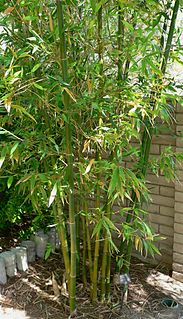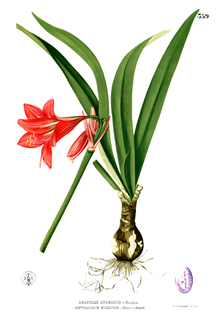Didymocistus is a genus of plants in the Phyllanthaceae first described as a genus in 1940. It contains only one known species, Didymocistus chrysadenius, native to the Loreto region of northeastern Peru, the Amazonas Department of southeastern Colombia, and the State of Amazonas in northwestern Brazil.

Heliconia rostrata is an herbaceous perennial native to Peru, Bolivia, Colombia, Costa Rica, and Ecuador, and naturalized in Puerto Rico. Other Heliconias grow in the upright position, their cup-shaped flower bracts storing water for birds and insects. This plant, however, has downward-facing flowers, the flowers thus providing a source of nectar to birds.

Dalechampia dioscoreifolia is a species of plant in the family Euphorbiacea first described in 1841. It is native to Central America and northern and western South America.

Bambusa oldhamii, known as giant timber bamboo or Oldham's bamboo, is a large species of bamboo. It is the most common and widely grown bamboo in the United States and has been introduced into cultivation around the world. It is densely foliated, growing up to 20 m tall in good conditions, and can have a diameter of up to 10 cm (4 inches).
Dielsiochloa is a genus of South American plants in the grass family. The only known species is Dielsiochloa floribunda, native to Bolivia, Peru, northwestern Argentina, and northern Chile.
Chrysactinium is a genus of South American flowering plants in the daisy family.
Porphyrostachys is a genus of flowering plants from the orchid family, Orchidaceae, native to South America. As of June 2014, it contains two known species:
Sutrina is a genus of flowering plants from the orchid family, Orchidaceae. The genus contains only two known species, both endemic to South America.

Oxalis ortgiesii is a species of Oxalis native to Bolivia, Ecuador, and Peru.
Jaltomata aspera is a plant species native to Peru. It grows on rocky hillsides at elevations less than 1800 m.

Jaltomata weberbaueri is a plant species native to Peru. It grows on rocky hillsides at elevations less than 1800 m.
Jaltomata cuyasensis is a plant species native to Peru. It grows on rocky hillsides at elevations less than 1800 m.
Jaltomata lojae is a plant species native to Peru and Ecuador.
Passiflora viridescens is a plant species native to Perú and Ecuador.

Hippeastrum miniatum is a flowering perennial herbaceous bulbous plant, in the Amaryllidaceae family, native to Peru.

Hippeastrum pardinum is a flowering perennial herbaceous bulbous plant, in the Amaryllidaceae family, from Peru to Bolivia. Originally collected in 1866 by Richard Pearce, it was used in breeding programmes.
Rauhia is a genus of Peruvian plants in the Amaryllis family.
Bulbophyllum pinelianum, the rat-tail orchid, is a species of orchid in the genus Bulbophyllum. It is widespread across southern Mexico, the West Indies, Central America and northern South America. It is also reported from Florida but apparently now extinct in that state.
Borrichia peruviana is a Peruvian species of flowering plants in the aster family. It is a perennial herb up to 150 cm tall. Flower heads are yellow, with both disc florets and ray florets.

Dr.Charlotte M. Taylor is a botanist and professor specialising in taxonomy and conservation. She works with the large plant family Rubiaceae, particularly found in the American tropics and in the tribes Palicoureeae and Psychotrieae. This plant family is an economically important group, as it includes plant species used to make coffee and quinine. Taylor also conducts work related to the floristics of Rubiaceae and morphological radiations of the group. Taylor has collected plant samples from many countries across the globe, including Chile, Colombia, Costa Rica, Panama, and the United States of America, and has named many new species known to science from these regions. As of 2015, Taylor has authored 278 land plant species' names, the seventh-highest number of such names authored by any female scientist.











